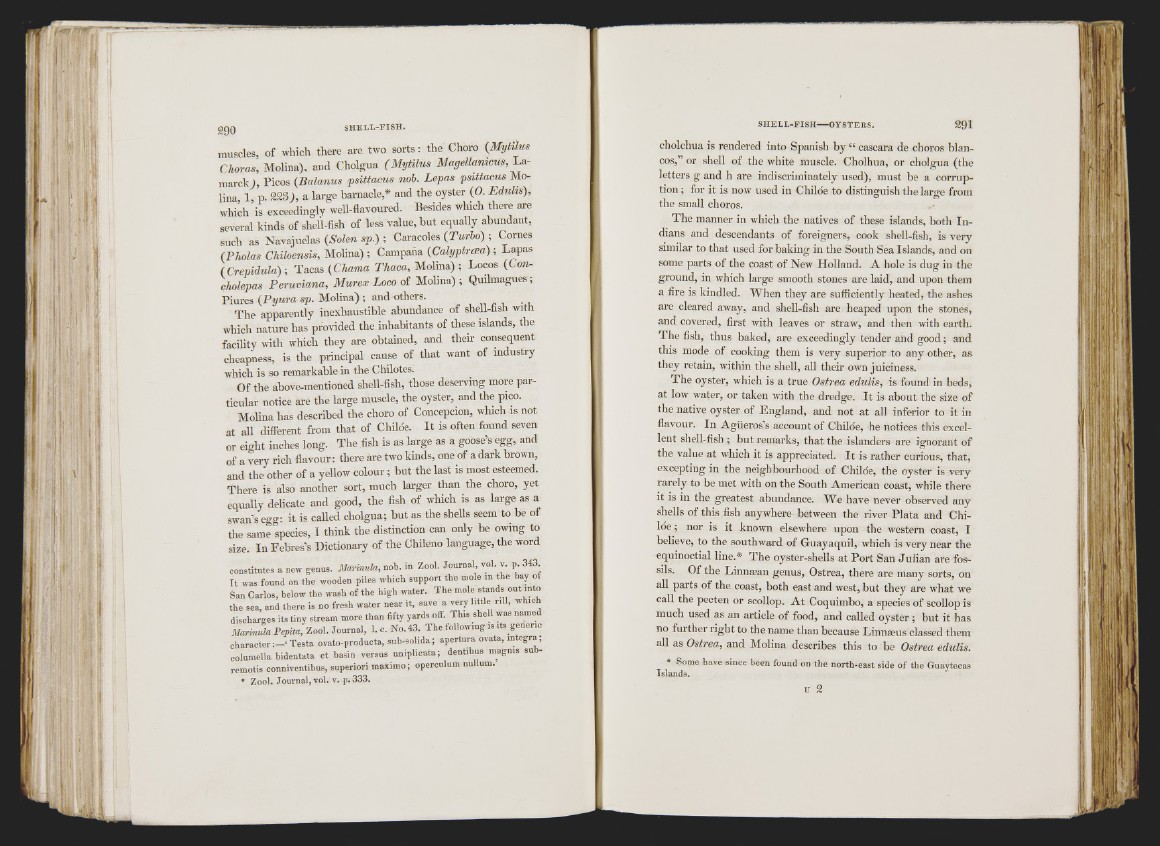
■¡if '
4 \ 4
290 SH E L L -F ISH .
muscles, of which there are two sorts: the Choro {Mytilus
Choras, Molina), and Cholgua (M y tilu s Magellanicus, Lamarck),
Picos {Balanus psittacus nob. Lepas psittacus Molina
1 p 223)) a large barnacle,* and the oyster (0 . Edulis),
whi/h’is exceedingly well-flavoured. Besides which there are
several kinds of shell-fish of less value, but equally abundant,
such as Navajuelas {Solen sp.) ; Caracoles {Turbo) ; Comes
{Pholas Chiloensis, Molina) ; Campaña {Calyptraa) ; Lapas
(Crepidula)-, Tacas {Chama Thaca, Molina) ; Locos {Concholepas
Peruviana, Murex Loco oi Molina); Quilmagues;
Piures {Pyura sp. Molina) ; and others.
The apparently inexhaustible abundance of shell-fish with
which nature has provided the inhabitants of these islands, the
facility with which they are obtained, and their consequent
cheapness, is the principal cause of that want of industry
which is so remarkable in the Chilotes.
Of the above-mentioned shell-fish, those deserving more particular
notice are the large muscle, the oyster, aud the pico.
Molina has described the choro of Concepcion, which is not
at all different from that of Chiloe. It is often found seven
or eight inches long. The fish is as large as a goose’s egg, and
of a very rich flavour: there are two kinds, one of adai-k brown,
and the other of a yeUow colour; but the last is most esteemed.
There is also another sort, much lai-ger than the choro, yet
equally delicate and good, the fish of which is as large as a
swan’s egg: it is called cholgua; but as the shells seem to be of
the same species, I think the distinction can only be owing to
size. In Febres’s Dictionary of the Chileno language, the word
constitutes a new genus. Marinula, nob. in Zool. Journal, vol. v. p. 343
I t was found on the wooden piles which support the mole in the bay of
San C arlos, below the wash of the high water. Th e mole stands out into
the sea, and there is no fresh water near it, save a very little n il, which
discharges its tiny stream more than fifty yards off. This shell was named
M a r i n i Pepita, Zool. Journal, 1. o. No. 43. T h e following is its generic
ch a ra c te r;—' Testa ovato-producta, sub-solida; apertura ovata, integra ,
columella bidentata et basin versus uniplicata; dentibus magnis sub-
remotis conniventibus, superior! máximo; operculum nullum.
• Zool. Journal, vol. v. p. 333.
S H E L L - F I S H OYSTERS. 291
cholchua is rendered into Spanish by “ cascara de choros blancos,”
or shell of the white muscle. Cholhua, or cholgua (the
letters g and h are indiscriminately used), must be a corruption
; for it is now used in Chiloe to distinguish the large from
the small choros.
The manner in which the natives of these islands, both Indians
and descendants of foreigners, cook shell-fish, is very
similar to that used for baking in the South Sea Islands, and on
some parts of the coast of New Holland. A hole is dug in the
ground, in which large smooth stones are laid, and upon them
a fire is kindled. When they are sufficiently heated, the ashes
are cleared away, and shell-fish are heaped upon tlie stones,
and covered, first with leaves or straw, and then with earth.
The fish, thus baked, are exceedingly tender and good; and
this mode of cooking them is very superior to any other, as
they retain, within the shell, all their own juiciness.
The oyster, which is a true Ostrea edulis, is found in beds,
at low water, or taken with the dredge. It is about the size of
the native oyster of England, and not at all inferior to it in
flavour. In Agiieros’s account of Chiloe, he notices this excellent
sliell-fish ; but remarks, that the islanders are ignorant of
the value at which it is appreciated. It is rather curious, that,
excepting in the neighbourhood of Childe, the oyster is very
rarely to be met with on the South American coast, while there
it is in the greatest abundance. We have never observed any
shells of this fish anywhere between the river Plata and Childe
; nor is it known elsewhere upon the western coast, I
believe, to the southward of Guayaquil, which is very near the
equinoctial line.* The oyster-shells at Port San Julian are fossils.
Of the Liiinaean genus, Ostrea, there are many sorts, on
all parts of the coast, both east and west, but they are what we
call the pecten or scollop. At Coquimbo, a species of scollop is
much used as an article of food, and called oyster; but it has
no further right to the name than because Linnseus classed them
all as Ostrea, and Molina describes this to be Ostrea edulis.
• Some have since been found on the north-east side of the Guaytecas
Islands.
I
u